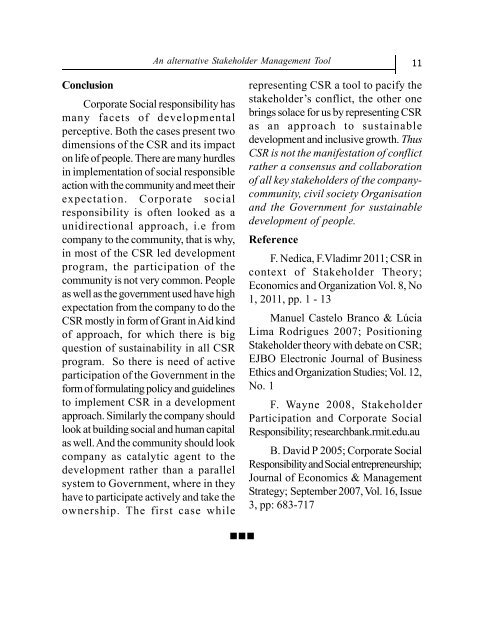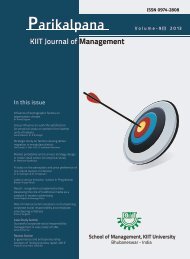Download - School of Management, KIIT University
Download - School of Management, KIIT University
Download - School of Management, KIIT University
You also want an ePaper? Increase the reach of your titles
YUMPU automatically turns print PDFs into web optimized ePapers that Google loves.
An alternative Stakeholder <strong>Management</strong> Tool<br />
11<br />
Conclusion<br />
Corporate Social responsibility has<br />
many facets <strong>of</strong> developmental<br />
perceptive. Both the cases present two<br />
dimensions <strong>of</strong> the CSR and its impact<br />
on life <strong>of</strong> people. There are many hurdles<br />
in implementation <strong>of</strong> social responsible<br />
action with the community and meet their<br />
expectation. Corporate social<br />
responsibility is <strong>of</strong>ten looked as a<br />
unidirectional approach, i.e from<br />
company to the community, that is why,<br />
in most <strong>of</strong> the CSR led development<br />
program, the participation <strong>of</strong> the<br />
community is not very common. People<br />
as well as the government used have high<br />
expectation from the company to do the<br />
CSR mostly in form <strong>of</strong> Grant in Aid kind<br />
<strong>of</strong> approach, for which there is big<br />
question <strong>of</strong> sustainability in all CSR<br />
program. So there is need <strong>of</strong> active<br />
participation <strong>of</strong> the Government in the<br />
form <strong>of</strong> formulating policy and guidelines<br />
to implement CSR in a development<br />
approach. Similarly the company should<br />
look at building social and human capital<br />
as well. And the community should look<br />
company as catalytic agent to the<br />
development rather than a parallel<br />
system to Government, where in they<br />
have to participate actively and take the<br />
ownership. The first case while<br />
representing CSR a tool to pacify the<br />
stakeholder’s conflict, the other one<br />
brings solace for us by representing CSR<br />
as an approach to sustainable<br />
development and inclusive growth. Thus<br />
CSR is not the manifestation <strong>of</strong> conflict<br />
rather a consensus and collaboration<br />
<strong>of</strong> all key stakeholders <strong>of</strong> the companycommunity,<br />
civil society Organisation<br />
and the Government for sustainable<br />
development <strong>of</strong> people.<br />
Reference<br />
F. Nedica, F.Vladimr 2011; CSR in<br />
context <strong>of</strong> Stakeholder Theory;<br />
Economics and Organization Vol. 8, No<br />
1, 2011, pp. 1 - 13<br />
Manuel Castelo Branco & Lúcia<br />
Lima Rodrigues 2007; Positioning<br />
Stakeholder theory with debate on CSR;<br />
EJBO Electronic Journal <strong>of</strong> Business<br />
Ethics and Organization Studies; Vol. 12,<br />
No. 1<br />
F. Wayne 2008, Stakeholder<br />
Participation and Corporate Social<br />
Responsibility; researchbank.rmit.edu.au<br />
B. David P 2005; Corporate Social<br />
Responsibility and Social entrepreneurship;<br />
Journal <strong>of</strong> Economics & <strong>Management</strong><br />
Strategy; September 2007, Vol. 16, Issue<br />
3, pp: 683-717<br />
•••







